Halifaxgithinji
On this page, you find all documents, package deals, and flashcards offered by seller halifaxgithinji.
- 216
- 0
- 10
Community
- Followers
- Following
2 Reviews received
226 items

Emergency Preparedness Response Course pretest (JFC100).pdf
1) Radiation burns, which cause delayed, irreversible changes of the skin, can be caused by high doses of what form of ionizing radiation? Neutron s Bet a Photo n Alph a 2) What is the role of the liaison officer within the Hospital Incident Command System (HICS)? Provide information to the media Function as the incident contact person for representatives from other agencies Carry out the response activities described in the Emergency Response Plan. Monitor the safety of rescue...
- Exam (elaborations)
- • 17 pages •
1) Radiation burns, which cause delayed, irreversible changes of the skin, can be caused by high doses of what form of ionizing radiation? Neutron s Bet a Photo n Alph a 2) What is the role of the liaison officer within the Hospital Incident Command System (HICS)? Provide information to the media Function as the incident contact person for representatives from other agencies Carry out the response activities described in the Emergency Response Plan. Monitor the safety of rescue...
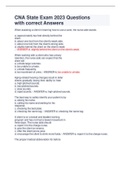
CNA State Exam 2023 Questions with correct Answers
When assisting a client in learning how to use a cane, the nurse aide stands a. approximately two feet directly behind the client. b. about one foot from the client's weak side. c. about one foot from the client's strong side. d. slightly behind the client on the client's weak . - ANSWER-d. slightly behind the client on the client's weak . When working with a client who has urinary retention, the nurse aide can expect that the client will a. urinate large volumes. b. be unable to ...
- Exam (elaborations)
- • 27 pages •
When assisting a client in learning how to use a cane, the nurse aide stands a. approximately two feet directly behind the client. b. about one foot from the client's weak side. c. about one foot from the client's strong side. d. slightly behind the client on the client's weak . - ANSWER-d. slightly behind the client on the client's weak . When working with a client who has urinary retention, the nurse aide can expect that the client will a. urinate large volumes. b. be unable to ...

HESI DOSAGE CALCULATIONS-LPN TO RN TRANSITION
CHRIS JAY-COPYRIGHT HESI DOSAGE CALCULATIONS-LPN TO RN TRANSITION 3 VERSIONS EXAM REAL EXAM SCORED 1200 CHRIS JAY-COPYRIGHT SAMPLE PREVIEW CHRIS JAY-COPYRIGHT SAMPLE/PREVIEW CHRIS JAY-COPYRIGHT Dose is 0.5 mg x kg Child’s weight is in pounds, so we have to convert it to kg 1 Kg = 2.2 pounds (lb) X kg = 42 lb X = 42*1/2.2 = 19 kg So the dose is 0.5 mg x 19 kg = 9.5 mg ---------------- that’s the 1st part to get into the final part of the question which is how many ml should be ...
- Package deal
- Exam (elaborations)
- • 86 pages •
CHRIS JAY-COPYRIGHT HESI DOSAGE CALCULATIONS-LPN TO RN TRANSITION 3 VERSIONS EXAM REAL EXAM SCORED 1200 CHRIS JAY-COPYRIGHT SAMPLE PREVIEW CHRIS JAY-COPYRIGHT SAMPLE/PREVIEW CHRIS JAY-COPYRIGHT Dose is 0.5 mg x kg Child’s weight is in pounds, so we have to convert it to kg 1 Kg = 2.2 pounds (lb) X kg = 42 lb X = 42*1/2.2 = 19 kg So the dose is 0.5 mg x 19 kg = 9.5 mg ---------------- that’s the 1st part to get into the final part of the question which is how many ml should be ...
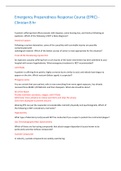
Emergency Preparedness Response Course (EPRC) - Clinician 8 hr
Emergency Preparedness Response Course (EPRC) - Clinician 8 hr A patient suffering blast effect presents with dyspnea, some hearing loss, and tinnitus following an explosion. Which of the following is NOT a likely diagnosis? Intestinal rupture Following a nuclear detonation, some of the casualties with survivable injuries are possibly contaminated with radiological material. Which of the below courses of action is most appropriate for the situation? Treat all life-threatening injuries fi...
- Exam (elaborations)
- • 14 pages •
Emergency Preparedness Response Course (EPRC) - Clinician 8 hr A patient suffering blast effect presents with dyspnea, some hearing loss, and tinnitus following an explosion. Which of the following is NOT a likely diagnosis? Intestinal rupture Following a nuclear detonation, some of the casualties with survivable injuries are possibly contaminated with radiological material. Which of the below courses of action is most appropriate for the situation? Treat all life-threatening injuries fi...
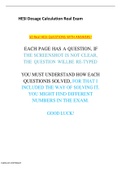
HESI Dosage Calculation Exam
CHRIS JAY-COPYRIGHT HESI Dosage Calculation Real Exam 50 Real HESI QUESTIONS WITH ANSWERS! EACH PAGE HAS A QUESTION, IF THE SCREENSHOT IS NOT CLEAR, THE QUESTION WILLBE RE-TYPED YOU MUST UNDERSTAND HOW EACH QUESTIONIS SOLVED, FOR THAT I INCLUDED THE WAY OF SOLVING IT, YOU MIGHT FIND DIFFERENT NUMBERS IN THE EXAM. GOOD LUCK! CHRIS JAY-COPYRIGHT Dose is 0.5 mg x kg Child’s weight is in pounds, so we have to convert it to kg 1 Kg = 2.2 pounds (lb) X kg = 42 lb X = 42*1/2.2 = 19 kg...
- Package deal
- Exam (elaborations)
- • 52 pages •
CHRIS JAY-COPYRIGHT HESI Dosage Calculation Real Exam 50 Real HESI QUESTIONS WITH ANSWERS! EACH PAGE HAS A QUESTION, IF THE SCREENSHOT IS NOT CLEAR, THE QUESTION WILLBE RE-TYPED YOU MUST UNDERSTAND HOW EACH QUESTIONIS SOLVED, FOR THAT I INCLUDED THE WAY OF SOLVING IT, YOU MIGHT FIND DIFFERENT NUMBERS IN THE EXAM. GOOD LUCK! CHRIS JAY-COPYRIGHT Dose is 0.5 mg x kg Child’s weight is in pounds, so we have to convert it to kg 1 Kg = 2.2 pounds (lb) X kg = 42 lb X = 42*1/2.2 = 19 kg...

ATLS WRITTEN REVIEW QUESTIONS ANSWERS LATEST A+ GRADED 100% VERIFIED.pdf
ATLS WRITTEN REVIEW QUESTIONS ANSWERS LATEST A+ GRADED 100% VERIFIED APPROVED BY: mater, pia Study online at 1. What is the primary goal of treating TBI? How is this done?: preventing secondary brain injury. This is done by maintaining blood pressure and providing adequate profusion. 2. After managing ABCDEs of TBI what MUST be identified if present? How is this done?: mass lesion that requires surgical evacuation is critical! this is done with CT. NOTE: obtaining a CT should not dela...
- Package deal
- Exam (elaborations)
- • 13 pages •
ATLS WRITTEN REVIEW QUESTIONS ANSWERS LATEST A+ GRADED 100% VERIFIED APPROVED BY: mater, pia Study online at 1. What is the primary goal of treating TBI? How is this done?: preventing secondary brain injury. This is done by maintaining blood pressure and providing adequate profusion. 2. After managing ABCDEs of TBI what MUST be identified if present? How is this done?: mass lesion that requires surgical evacuation is critical! this is done with CT. NOTE: obtaining a CT should not dela...
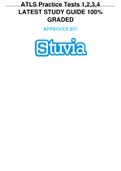
ATLS Practice Tests 1,2,3,4 LATEST STUDY GUIDE 100% GRADED.pdf
ATLS Practice Tests 1,2,3,4 LATEST STUDY GUIDE 100% GRADED APPROVED BY: ATLS Practice Test 1 1. Which one of the following is the recommended method for initially treating frostbite? a. vasodilators b. anticoagulants c. warm (40°C) water d. padding and elevation e. application of heat from a hair dryer 2. A 6yearold boy is struck by an automobile and brought to the emergency department. He is lethargic, but withdraws purposefully from painful stimuli. His blood pressure is 90 mm H...
- Package deal
- Exam (elaborations)
- • 41 pages •
ATLS Practice Tests 1,2,3,4 LATEST STUDY GUIDE 100% GRADED APPROVED BY: ATLS Practice Test 1 1. Which one of the following is the recommended method for initially treating frostbite? a. vasodilators b. anticoagulants c. warm (40°C) water d. padding and elevation e. application of heat from a hair dryer 2. A 6yearold boy is struck by an automobile and brought to the emergency department. He is lethargic, but withdraws purposefully from painful stimuli. His blood pressure is 90 mm H...

ATLS PRACTICE QUESTIONS AND ANSWERS A+ GRADED 100% VERIFIED 2023.pdf
ATLS PRACTICE QUESTIONS AND ANSWERS A+ GRADED 100% VERIFIED 2023 ATLS Practice Study online at 1. Definitive control of the airway is achieved by : Endotracheal intubation 2. How do you treat hypothermia in the ED?: crystalloid fluids at 102.2 degrees F and warmed treatment area 3. What does definitive hemorrhage control refer to? (3): 1) Possible surgery 2) Stabilizing of pelvis 3) Angioembolization 4. What are rates of fluid administration measured by?: Size and length of cathete...
- Package deal
- Exam (elaborations)
- • 10 pages •
ATLS PRACTICE QUESTIONS AND ANSWERS A+ GRADED 100% VERIFIED 2023 ATLS Practice Study online at 1. Definitive control of the airway is achieved by : Endotracheal intubation 2. How do you treat hypothermia in the ED?: crystalloid fluids at 102.2 degrees F and warmed treatment area 3. What does definitive hemorrhage control refer to? (3): 1) Possible surgery 2) Stabilizing of pelvis 3) Angioembolization 4. What are rates of fluid administration measured by?: Size and length of cathete...
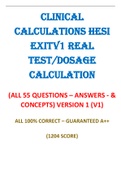
HESI-CLINICAL CALCULATIONS -dosage calculation
CLINICAL CALCULATIONS HESI EXIT V1 Real Test/dosage calculation (ALL 55 QUESTIONS – ANSWERS - & CONCEPTS) VERSION 1 (V1) ALL 100% CORRECT – GUARANTEED A++ (1204 SCORE)
- Package deal
- Exam (elaborations)
- • 13 pages •
CLINICAL CALCULATIONS HESI EXIT V1 Real Test/dosage calculation (ALL 55 QUESTIONS – ANSWERS - & CONCEPTS) VERSION 1 (V1) ALL 100% CORRECT – GUARANTEED A++ (1204 SCORE)
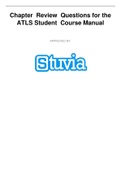
Chapter Review Questions for the ATLS Student Course Manual.pdf
Chapter Review Questions for the ATLS Student Course Manual APPROVED BY: Chapter Review Questions for the ATLS Student Course Manual Dr. Ken Evans, MD Chapter 1 Initial Assessment and Management A cast-cutter should be used to remove a trauma victim's helmet if there is evidence of a C-spine injury or if . the patient experiences pain or paresthesias during an initial attempt to remove the helmet. The "A" in ABCDE stands for . Airway; however, always be cautious about and prot...
- Exam (elaborations)
- • 37 pages •
Chapter Review Questions for the ATLS Student Course Manual APPROVED BY: Chapter Review Questions for the ATLS Student Course Manual Dr. Ken Evans, MD Chapter 1 Initial Assessment and Management A cast-cutter should be used to remove a trauma victim's helmet if there is evidence of a C-spine injury or if . the patient experiences pain or paresthesias during an initial attempt to remove the helmet. The "A" in ABCDE stands for . Airway; however, always be cautious about and prot...

ATI PHARMACOLOGY PROCTORED TEST BANK LATEST VERSION 2023
ATLS MCQ-QUESTIONS&ANSWERS BEST FOR 2023.pdf